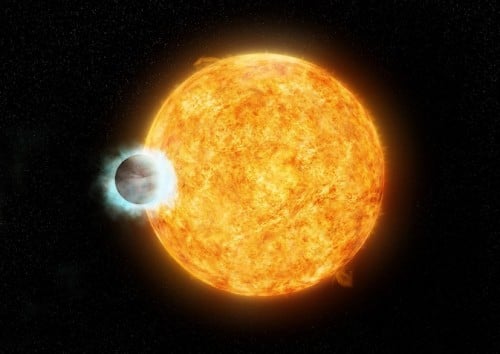Planets may make their Saturn stars look much older than they really are, new data from NASA's Chandra Space Telescope shows.

Planets may make their Saturn stars look much older than they really are, new data from NASA's Chandra Space Telescope shows.
The star WASP-18 and its planet, WASP-18b are located 330 light-years from Earth. The mass of WASP-18b is 10 Jupiter masses and the duration of its orbit around its star is less than 23 hours, which places the star in the category of exoplanets (planets outside the solar system) called "hot Jupiter".
WASP-18b is the first observed example to date of a planet that causes its star, which is about the mass of our Sun, to show the properties of an older star than it actually is.
"WASP-18b is an extreme exoplanet," says Ignazio Filitri, from the Palermo Astronomical Observatory, which belongs to the Italian National Institute of Astrophysics (INAF), who led the research. "This is one of the huge planets included in the category of the "hot Jupiters" and one of the closest to its Saturn planet, and these characteristics lead to unpredictable behavior. This planet makes its Saturn star look more ancient than it is."
Pilitri's team dated the star WASP-18 to between 500 million and 2 billion years, based on theoretical models and additional information. While this may sound ancient, it is considered young by astronomical standards. For comparison, our sun is about 5 billion years old and is currently halfway through its life.
Young stars tend to be more active, exhibit stronger magnetic fields, larger solar flares, and more intense X-ray emissions than their older counterparts. Magnetic activity, outbursts, and X-ray emission are directly related to the self-rotation of the star, which generally declines with the age of the star. However, when astronomers with Chandra examined WASP-18 they did not detect any X-rays. Using established relationships between the magnetic activity and X-ray emission of stars, relative to its age, the researchers found that WASP-18 is 100 times less active than it should be.
"We think that a planet ages its Saturn planet by wreaking havoc on its core," said Scott Wolk of the Harvard-Smithsonian Center for Astrophysics in Cambridge, co-author of the paper.
The researchers claimed that tidal forces created by the massive planet's gravity - similar to those that appear in the Earth due to the moon, but on a much larger scale - could have disrupted the star's magnetic field. The strength of the magnetic field depends on how strongly the material in the star is convected, or how strongly hot gas moves inside the star.
"The star's gravity may cause movements of gas inside the star, which weakens the convection," said Salvatore Shortino, also a member of the Palermo Astronomical Observatory, and co-author of the article. "This is a domino effect, at the end of which the magnetic field weakens and the star ages prematurely."
WASP-18 is particularly sensitive to this effect because its convection region is narrower than most stars. And this makes it more vulnerable to the influence of tidal forces.
The phenomenon of tidal forces created in this case could also explain the higher-than-normal amount of lithium found in earlier optical studies of WASP-18. Lithium is usually abundant in younger stars, but over time, convection carries it to the hot, inner regions of the star, where it breaks down in nuclear fusion processes. If there is less convection, the lithium is less likely to flow into the face of the star, allowing more lithium to survive.
The findings were published in the July issue of the journal Astronomy and Astrophysics
The original article on the NASA website
